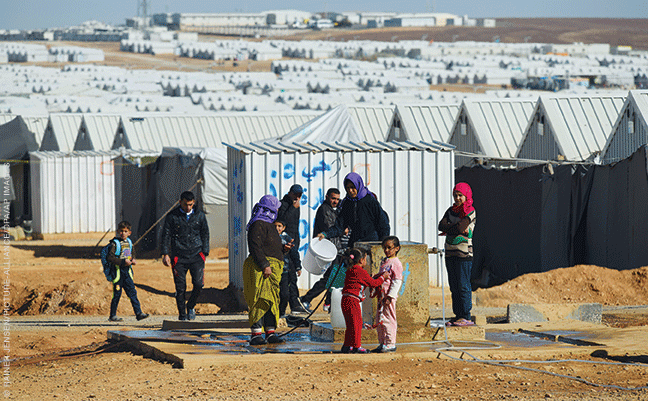
Anxiety, xenophobia, and sympathy from an unexpected source.
By Mitchell Orenstein | The current exodus out of Syria is a modern epic. The scale of the destruction in Syria is hard to imagine. Out of a pre-war population of 23 million, more than half have fled their homes. Some 8 million are internally displaced. Nearly 4 million have left the country for Lebanon, Turkey, Jordan, and Europe, according to the UN High Commissioner for Refugees. Approximately 250,000 people have been killed in the fighting.
One in four persons in Lebanon today is a Syrian refugee. After initially welcoming refugees with open arms, that country has now closed its doors. Turkey and Jordan have built refugee camps the size of small cities. The Zaatari camp in Jordan now houses 80,000 refugees. Yet the capacity of many camps has nevertheless been exceeded, and many refugees live wherever they can among the local population, with friends, relatives, or in the open. Today in Istanbul it is impossible to walk down the street without bumping into Syrian refugees begging for their survival.
A relatively small, but growing, share of the total refugee population has made its way to Europe, usually by boat from Turkey to Greece and up through the Balkans to Germany or Sweden. Yet these refugees—a total of 681,000 between 2011 and 2015 according to the UNHCR, with some 450,000 entering in 2015 alone—have caused a deepening disarray in Europe. The steeply increasing number of Syrians, combined with a growing influx from other conflict zones, has overwhelmed Europe’s borders. European Union member states like Hungary have reacted unilaterally by building walls and fences along the EU’s external border, triggering fierce debate within the EU. Some, like Slovenia and Austria, have even attempted to build border fences between themselves and other EU states, in an effort to stop the flow of refugees that is overwhelming the systems in place to manage them. Scenes of Syrian refugees trapped in the Budapest train station and being forced to walk to Austria—a country that was, for the moment anyway, more welcoming—galvanized debate in Europe over how a union founded to protect peace and human rights had come to behave so inhumanely to refugees from war. Many believe the Syrian refugee crisis is a test of the soul of the EU, and of its very existence.
The Syrian refugee crisis has already damaged, perhaps irreparably, one of the four freedoms of the EU: the freedom of movement. Until this year, people moved freely within the so-called “Schengen zone,” where passport-free travel was the norm and border controls were nonexistent. Now, a combination of anxiety about the refugees and terrorist attacks by ISIS—one of the organizations that set these refugees on the move in the first place—have imperiled that fundamental liberty.
The Paris attacks last November added an additional twist.
Already, the influx of Syrians had proven controversial in Europe. Some countries, led by Germany and Sweden, warmly welcomed the refugees. They did so for several reasons. First, political leaders such as German Chancellor Angela Merkel saw the refugee crisis as a moral and even existential test for the European Union. It was a chance to show that Europe was more than a customs union, more than an economic union, but a values union with the capacity and mission to lead the continent towards the politics of light and away from darkness. This opportunity to show Europe as a community of values was particularly important at a time of multiple roiling crises over Greece and sovereign debt. Second, the refugee crisis provided an opportunity to improve Europe’s relations with the Islamic world and challenge the notion that Europe was an exclusively Christian club. Third, Europe’s aging populations will require someone to support them. Young, able Syrians could provide a boost to the demographic profile of states like Germany, since refugees and immigrants tend to be in the prime of their working age.
Yet Europe’s xenophobes opposed refugee flows, hoping to guard the Christian character of the Europe of their imagination. Many Central and East European countries—which had become remarkably homogeneous after the killing, expulsions, and border movements of World War II—had no desire to welcome large new Muslim populations.
Then, there was the question of terrorism. While the vast majority of Syrian refugees are innocents fleeing terrorism and bloodshed at home, some reports have suggested that the exodus includes former combatants as well. Some politicians and commentators have asserted that armies operating in Syria, such as ISIS, could use the Syrian refugee flows as cover for insinuating themselves into Europe.
One of the great parables of this exodus was the story of Osama Abdul Mohsen, who was tripped by a right-wing-television camerawoman while running across the Hungarian border clutching a small child. He was photographed falling to the ground on top of his son—an image that went round the world as an example of the inhumanity with which Hungarians were treating these vulnerable refugees. Due to the publicity, Mohsen, who turned out to be a soccer coach, was offered a job coaching soccer at the Cenafe soccer academy in Spain. He became a celebrity in Spain and appeared with his son at a Real Madrid match with Cristiano Ronaldo. A few days later, the Syrian Kurdish Democratic Union Party accused Mohsen of being a member of the Al-Qaeda-linked Al-Nusra Front.“Osama Abdul joined the rebel groups in 2011 and committed crimes against civilian minorities, including Kurds,” the party alleged in a statement it said was based partly on evidence from Mohsen’s Facebook page. They claimed that he had fled from Syria to Turkey as the Kurds seized his hometown of Tel Abyad.
This vignette contains almost the full range of responses to the Syrian refugee crisis: from xenophobic to heroic to anxious. Europe will spend years sorting this out.
On Friday, November 13, 2015, Islamic State militants conducted a coordinated shooting and bombing attack on several sites in Paris, killing 130 people, most of them in a single concert hall, Le Bataclan. Dozens of others were shot in restaurants in Paris’s 10th and 11th arrondisements. Immediately, people began searching for a Syrian connection. A passport left at the scene indicated that one of the perpetrators of the attack had entered Europe with Syrian refugees via Greece. It later turned out to be falsified. A Syrian connection did emerge, however. A number of the perpetrators had fought in Syria—although they were primarily citizens of France and Belgium, radicalized and converted to Islamist terrorism.
Although the perpetrators were not Syrian refugees, European opinion suddenly turned against refugees from Syria, as people began to wonder whether terrorists were hiding among them. Poland announced that it would no longer accept the 7,000 Syrian refugees it had committed to take under pressure from Germany. Slovakia promised to “monitor all Muslims” on its territory. Other countries hardened their stance. Some argued that if even a small proportion of the Syrian refugees were terrorists, it was not worth allowing any of them to enter the country. Others saw this as a particularly egregious case of blaming the victims of this terrible conflict.
Anti-refugee discourse has taken hold in the United States as well. Although the US has done very little to accept Syrian refugees, President Obama promised to accept 10,000 refugees in 2016—a drop in the bucket compared to the 2 million residing in Turkey. After the Paris attacks, 26 Republican governors announced that Syrian refugees would not be welcome in their states. Texas governor Greg Abbott stated, “Neither you nor any federal official can guarantee that Syrian refugees will not be part of any terroristic activity.”
In an interesting local twist on this story, the Philadelphia Jewish community—like the American Jewish community nationally—has led the way in expressing sympathy and support for resettling Syrian refugees in the US. Pennsylvania is among the states supporting Syrian refugee resettlement, with funding and other support from organizations like HIAS—which was founded in 1881 as the Hebrew Immigrant Aid Society, to assist Jews fleeing pogroms in Russia and Eastern Europe. Many American Jews see parallels between the Syrians fleeing from persecution and war and the experience of Jews being turned away from country after country in the 1920s and 1930s. While no doubt feeling some anxiety about helping a people whose political regime and popular opinion has been staunchly anti-Israel and anti-Semitic, the legitimate nature of Syrians’ flight apparently matters more to many American Jews. Sixteen out of 19 Jews in the US Congress voted against the Republican-initiated H.R. 4038, the “American Security Against Foreign Enemies Act,” which passed the House of Representatives on November 19 and would effectively bar Syrian refugees from coming to the US. Potent memories of similar exclusion have spurred the Jewish community to reach out to those in need of resettlement.
Like the Jews of old, present-day Syrians seem destined to wander in the wilderness, victims of a war that was fueled, at least in part, by foreign powers that will not take responsibility for the human consequences of their actions. Neither accepted nor trusted by the people they shelter among, the masses of Syrian refugees attest to the utter devastation of their country and the belief of many that they cannot go back.




